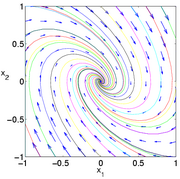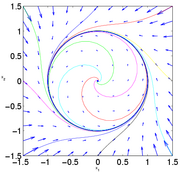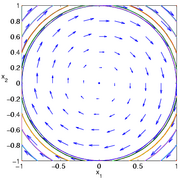New Dynamic Behavior
| Prev: Examples | Chapter 4 - Dynamic Behavior | Next: Linear Systems |
In this chapter we give a broad discussion of the behavior of dynamical systems, focused on systems modeled by nonlinear differential equations. This allows us to discuss equilibrium points, stability, limit cycles and other key concepts of dynamical systems. We also introduce some methods for analyzing global behavior of solutions.
Textbook ContentsDynamic Behavior (pdf, 30Jan08)
|
Lecture MaterialsSupplemental Information
|
Chapter Summary
This chapter introduces the basic concepts and tools of dynamical systems.
-
We say that
 is a solution of a differential equation on the time interval
is a solution of a differential equation on the time interval  to
to  with initial value
with initial value  if it satisfies
if it satisfies

 . For most differential equations we will encounter, there is a unique solution for a given initial condition. Numerical tools such as MATLAB and Mathematica can be used to obtain numerical solutions for
. For most differential equations we will encounter, there is a unique solution for a given initial condition. Numerical tools such as MATLAB and Mathematica can be used to obtain numerical solutions for  given the function
given the function  .
.
An equilibrium point for a dynamical system represents a point
 such that if
such that if  then
then  for all
for all  . Equilibrium points represent stationary conditions for the dynamics of a system. A limit cycle for a dynamical system is a solution
. Equilibrium points represent stationary conditions for the dynamics of a system. A limit cycle for a dynamical system is a solution  which is periodic with some period
which is periodic with some period  , so that
, so that  for all
for all  .
.An equilibrium point is (locally) stable if initial conditions that start near an equilibrium point stay near that equilibrium point. A equilibrium point is (locally) asymptotically stable if it is stable and, in addition, the state of the system converges to the equilibrium point as time increases. An equilibrium point is unstable if it is not stable. Similar definitions can be used to define the stability of a limit cycle.
Phase portraits provide a convenient way to understand the behavior of 2-dimensional dynamical systems. A phase portrait is a graphical representation of the dynamics obtained by plotting the state
 in the plane. This portrait is often augmented by plotting an arrow in the plane corresponding to
in the plane. This portrait is often augmented by plotting an arrow in the plane corresponding to  , which shows the rate of change of the state. The following diagrams illustrate the basic features of a dynamical systems:
, which shows the rate of change of the state. The following diagrams illustrate the basic features of a dynamical systems:



An asymptotically stable equilibrium point at  .
.
A limit cycle of radius one, with an unstable equilibrium point at  .
.
A stable equlibirum point at  (nearby initial conditions stay nearby).
(nearby initial conditions stay nearby).
</p>
A linear system

is asymptotically stable if and only if all eigenvalues of
 all have strictly negative real part and is unstable if any eigenvalue of $A$ has strictly positive real part. A nonlinear system can be approximated by a linear system around an equilibrium point by using the relationship
all have strictly negative real part and is unstable if any eigenvalue of $A$ has strictly positive real part. A nonlinear system can be approximated by a linear system around an equilibrium point by using the relationship

Since
 , we can approximate the system by choosing a new
state variable
, we can approximate the system by choosing a new
state variable  and writing the dynamics as
and writing the dynamics as  . The stability of the nonlinear system can be determined in a local neighborhood of the equilibrium point through its linearization.
. The stability of the nonlinear system can be determined in a local neighborhood of the equilibrium point through its linearization.
A Lyapunov function is an energy-like function
 that can be used to reason about the stability of an equilibrium point. We define the derivative of
that can be used to reason about the stability of an equilibrium point. We define the derivative of  along the trajectory of the system as
along the trajectory of the system as

Assuming
 and
and  , the following conditions hold:
, the following conditions hold:
Condition on 
Condition on 
Stability 
 for all
for all 
 stable
stable


 asymptotically stable
asymptotically stable
Stability of limit cycles can also be studied using Lyapunov functions.
The Krasovskii-LaSalle Principle allows one to reason about asymptotic stability even if the time derivative of
 is only negative semi-definite (
is only negative semi-definite ( rather than
rather than  ). Let
). Let  be a positive definite function,
be a positive definite function,  for all
for all  and
and  , such that
, such that
Then as
 , the trajectory of the system will converge to the largest invariant set inside
, the trajectory of the system will converge to the largest invariant set inside
 .
.In particular, if
 contains no invariant sets other than
contains no invariant sets other than  , then 0 is asymptotically stable.
, then 0 is asymptotically stable.
The global behavior of a nonlinear system refers to dynamics of the system far away from equilibrium points. The region of attraction of an asymptotically stable equilirium point refers to the set of all initial conditions that converge to that equilibrium point. An equilibrium point is said to be globally asymptotically stable if all initial conditions converge to that equilibrium point. Global stability can be checked by finding a Lyapunov function that is globally positive definition with time derivative globally negative definite.
</ol>
Exercises
Frequently Asked Questions
- FAQ: Does a stable system have a stable equilibrium point? a limit cycle?
- FAQ: How do we choose epsilon in the definition of stability?
- FAQ: How do you plot a 3D phase portrait?
- FAQ: If every equilibrium point can be transformed to the origin and then analyzed using a Lyapunov function, how can a system have both stable and unstable equilibrium points?
- FAQ: What do the double vertical bars mean at the end of Section 4.1?
- FAQ: Who is Lyapunov?
Errata
- Errata: Solution for x 2j in block diagonal form discussion has sign errors
- Errata: At the end of Example 4.6, the roots should have negative real part instead of being positive
- Errata: Closed loop dynamics matrix is incorrect in Example 4.6
- Errata: In Example 4.6, u d is not computed correctly
- Errata: Missing γ in equation (4.9)
- Errata: In Example 4.8, the linearized dynamics should contain 3 r e, not 2 r e
- Errata: In Example 4.9, V(x) should be V(z)
- Errata: In Example 4.11, Taylor series term is missing factor of 1/2
- Errata: In Example 4.11, Lyapunov equation entries for f' 1 and f' 2 are switched (solution is correct)
- Errata: Near end of Example 4.11, denominator of f'(z 2e) term should be squared
- Errata: Typo in the caption for Figure 4.15
- Errata: Global Lyapunov stability requires additional conditions
- Errata: In Example 4.13, inequality should be for x 1 instead of x 2
- Errata: In Figure 4.18, v and V should be v0
- Errata: In Exercise 4.1, tau should be defined as t-t 0
- Errata: In Exercise 4.1, x 0 should not be subtracted from time-shifted solution
- Errata: In Exercise 4.2, a e should be a
- Errata: In Exercise 4.2, the q in term should be positive
- Errata: Sign error in second Lyapunov function in Exercise 4.4
- Errata: In Exercise 4.6, Pm/J should be taken as 1 and factor of 1/2 is misplaced
- Errata: In Exercise 4.12, some additional assumptions are required for oscillation
- Errata: In Exercise 4.14c, the transformation T and its inverse are swapped
- Errata: Equation (4.4) is labeled incorrectly
Additional Information
- Control tutorials for MATLAB (U. Michigan)
